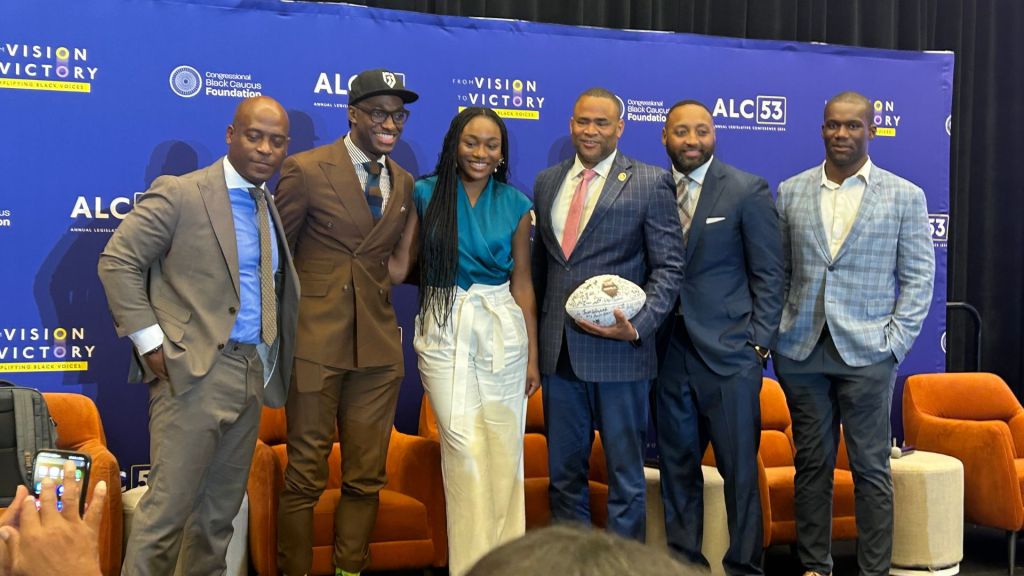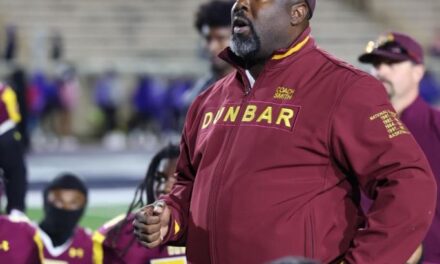By D. Kevin McNeir
Special to the AFRO
A panel of current and former Black college athletes and legal experts addressed the economic impact of the historic House v. NCAA $2.8 billion settlement and what it could mean in terms of annual revenue sharing for Black student-athletes in the future during the recent Annual Legislative Conference of the Congressional Black Caucus Foundation in Washington, D.C.

The panel also considered policy implications of the case and the potential responses from Congress, which can protect and maximize the economic interests of athletes as they consider the NCAA’s efforts to secure antitrust safeguards from future litigation initiated by college athletes.
The panel discussion, sponsored by U.S. Rep. Marc Veasey (D-Texas-03), was moderated by Rob Robertson, a former fullback with the Baltimore Ravens who was reelected in 2023 as the D.C. chapter president of the National Football League Players Association.
Joining Robertson on the panel were: Gabby Anderson, a young artist whose business endeavors include a custom shoe company, Graffiti by Gabby, and who is also a college junior and member of the Harvard University women’s basketball team; Donovan Porter, an attorney specializing in business, sports and entertainment law and a former Division I college football player at Miami University (Ohio); Robert Griffin III (nicknamed RG3), a former standout quarterback at Baylor University, currently a sports broadcaster, who played nine seasons in the National Football League, most notably with the Washington Commanders and retired as a Baltimore Raven; and Shakeel Rashad, a former linebacker for the University of North Carolina and currently the director of membership at athletes.org, a players’ association dedicated to ensuring that college athletes have access to essential resources and the ability to voice their concerns.
Backdrop for the panel’s insightful discussion
On May 23, 2024, the NCAA reached an historic $2.8 billion settlement with former college athletes who had filed an antitrust class action demanding billions in potential earnings allegedly denied to them for decades. The landmark settlement represents a major turning point in college athletics and falls in line with previous rulings in federal courts that have chipped away at the NCAA’s long-standing prohibition against student-athletes monetizing their athletic abilities.
But while the NCAA, in conjunction with five major conferences (Big Ten, Big 12, Atlantic Coast, Pac-12 and Southeastern) and plaintiffs in three antitrust lawsuits related to athlete compensation, has agreed to the settlement, U.S. District Judge Claudia Wilken declined to grant preliminary approval. Wilken, who expressed dismay with a plan to regulate and potentially restrict third-party name, image and likeness (NIL) payments to athletes from booster-funded organizations called collectives, has set a Sept. 26 deadline for attorneys on both sides to report back to her with certain parts of the settlement agreement reworked.
According to comments from Rep. Veasey and Robertson, shared before the panelists were allowed to weigh in, Black football and men’s and women’s basketball athletes at the Division I Power 5 Conference level have lost approximately $17 billion to $21 billion in compensation from 2005 to 2019, roughly $1.2 – $1.4 billion per year.
Additional estimates suggest that in 2017–2020 alone, $10 billion was funneled to Power 5 coaches and administrators that could have been shared by football and men’s and women’s basketball players who are disproportionately Black.
However, with revenue sharing in collegiate athletics now a reality because of the House v. NCAA settlement, Black college athletes stand to benefit most from the approximately $2.8 billion settlement and annual revenue sharing moving forward.
“Athletes have lost billions in compensation for their NIL with a lot of that money going to coaches and staff but not to the players, many of whom look like us (Black),” Robertson said. “And for most of them, college will be their last opportunity to receive any financial compensation as athletes as only a very small percentage of college athletes will move on and secure financial stability in professional sports.”
Robertson said he felt fortunate that he moved on to the pros, especially coming from humble beginnings in Baton Rouge, Louisiana, and being able to provide for his family, particularly the matriarch of his family – his grandmother.
“People see the success that teams achieve but they don’t see the sacrifices made by the athletes,” Robertson said.
What’s at stake for college athletes
Porter said he believes that the attorneys on both sides will find a way to resolve the judge’s reluctance to approve the settlement.
“In a case like this, the judge must approve a settlement but if not, the case must go to trial, and I cannot see the NCAA being willing to let that happen because of the financial impact it could have on them,” Porter said.
The settlement allows Division I college athletes to receive pay directly from the universities they compete for — a complete departure from the NCAA’s long-standing system of “amateurism” – and includes, but is not limited to, the NCAA agreeing to pay upward of $2.75 billion in back-pay damages to former Division I athletes who were unable to profit on their NIL rights, as well as a future revenue sharing model between the Power Five conference schools and athletes.
What’s at stake for college athletic departments
If the settlement becomes final, the financial impact for athletic departments, especially among major conferences, will be significant. While the NCAA can absorb the main share of the cost via its reserves, insurance and budget cuts, the schools themselves do not possess that same benefit. Some schools have suggested that they could lose as much as $30 million per year over the next 10 years to cover revenue-sharing distribution, back damages and expanded scholarship costs.
But as Rashad noted, the real losers have long been college athletes – something that the settlement will help to rectify.
“As an advocate for college athletes and part of an organization that brings them up to speed on financial literacy, I am always amazed to hear people complain about the possibility of them receiving revenue for their name, image and likeness,” Rashad said.
“College athletes collectively help generate the billions of dollars that athletic departments receive. Schools are racking in the dollars but, beyond room and board, players do not receive any additional compensation,” Rashad continued. “I know of many cases in which players’ families have never even seen them play because they couldn’t afford to get them to their games. Those are the kinds of stories that don’t make the headlines but are just as real and just as frequent in college sports.”
Griffin described some of the hardships that he faced, even as one of the nation’s best college quarterbacks during his years at Baylor.
“When I arrived on campus, I learned about the ‘Baylor bubble,’ which was the innermost portion of campus – miles and miles of beautiful, green grass and beautiful homes,” he said. “But outside of the bubble, it was a very different city both for players who were living in Waco, Texas, temporarily and especially for the city’s residents. Our football team, given our success, fought to expand that bubble and that’s something I’m very proud of.”
As a student-athlete living outside that bubble, life was a daily battle, Griffin said.
“People don’t realize that college athletes work from 5 a.m. to 9 a.m., rushing to practice, rushing to find something to eat, rushing to get to class and then doing it all over again, day after day. There’s no time for fraternities or sororities or parties,” he said. “I received both an athletic and academic scholarship at Baylor but the University took my academic scholarship back. I struggled to pay rent and I ate at Subway almost every day because that’s all I could afford.”
To add insult to mental, physical and financial injury, he added, many student athletes find their sport dreams cut short after college.
“Only about 2 percent (1.6 percent, according to the NCAA as of March 16, 2024) of NCAA football players go on to the NFL,” said Griffin, who was known as RGIII during his eight seasons in the league. “The rest limp out of college with injuries, some without receiving a degree, and many leave behind cheering crowds only to find a far more mundane reality. It’s a shock and a tough reality to accept.”
Anderson has already cemented her future financially with a graffiti business that she started at the age of 16. She has since signed contracts to design shoes for athletes and friends and has collaborated with Fortune 500 companies like Nike and Walmart. Still, she said, being a student-athlete is difficult.
“We don’t sleep much and we work very hard,” she said. “People often think that we have it easy but that’s just not the case. I appreciate the opportunities I’ve been given at Harvard but it’s a job and we are expected to perform at the highest level possible.”
Griffin said he’s glad to see that change is finally coming.
“You always hear about coaches like Nick Sabine or Bear Bryant who built legacies,” he said, “but remember, they built those legacies on the backs of talented players – players who deserve to have a seat at the table and a fair percentage of the revenue that has long been funneled into university war chests.”
The post Current, former Black college athletes discuss impact of historic $2.8B NCAA settlement appeared first on AFRO American Newspapers.











